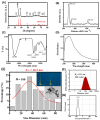Co-Treatment of Copper Oxide Nanoparticle and Carbofuran Enhances Cardiotoxicity in Zebrafish Embryos
- PMID: 34361024
- PMCID: PMC8435221
- DOI: 10.3390/ijms22158259
Co-Treatment of Copper Oxide Nanoparticle and Carbofuran Enhances Cardiotoxicity in Zebrafish Embryos
Abstract
The use of chemicals to boost food production increases as human consumption also increases. The insectidal, nematicidal and acaricidal chemical carbofuran (CAF), is among the highly toxic carbamate pesticide used today. Alongside, copper oxide nanoparticles (CuO) are also used as pesticides due to their broad-spectrum antimicrobial activity. The overuse of these pesticides may lead to leaching into the aquatic environments and could potentially cause adverse effects to aquatic animals. The aim of this study is to assess the effects of carbofuran and copper oxide nanoparticles into the cardiovascular system of zebrafish and unveil the mechanism behind them. We found that a combination of copper oxide nanoparticle and carbofuran increases cardiac edema in zebrafish larvae and disturbs cardiac rhythm of zebrafish. Furthermore, molecular docking data show that carbofuran inhibits acetylcholinesterase (AChE) activity in silico, thus leading to impair cardiac rhythms. Overall, our data suggest that copper oxide nanoparticle and carbofuran combinations work synergistically to enhance toxicity on the cardiovascular performance of zebrafish larvae.
Keywords: CuO nanoparticle; carbofuran; cardiotoxicity; molecular docking; zebrafish.
Conflict of interest statement
The authors declare no conflict of interest. The funders had no role in the design of the study; in the collection, analyses, or interpretation of data; in the writing of the manuscript, or in the decision to publish the results.
Figures














Similar articles
-
Carbofuran and malathion inhibit nucleotide hydrolysis in zebrafish (Danio rerio) brain membranes.Toxicology. 2005 Sep 1;212(2-3):107-15. doi: 10.1016/j.tox.2005.04.007. Toxicology. 2005. PMID: 15951093
-
Noncovalent binding of carbofuran to acetylcholinesterase from Homo sapiens, Danio rerio, Apis mellifera and Caenorhabditis elegans: Homology modelling, molecular docking and dynamics, and quantum biochemistry description.Chem Biol Interact. 2024 Jan 25;388:110826. doi: 10.1016/j.cbi.2023.110826. Epub 2023 Dec 13. Chem Biol Interact. 2024. PMID: 38101596
-
Responses of Hexaplex (Murex) trunculus to selected pollutants.Sci Total Environ. 2006 Apr 15;359(1-3):135-44. doi: 10.1016/j.scitotenv.2005.09.071. Epub 2005 Oct 27. Sci Total Environ. 2006. PMID: 16257038
-
Carbofuran pesticide toxicity to the eye.Exp Eye Res. 2023 Feb;227:109355. doi: 10.1016/j.exer.2022.109355. Epub 2022 Dec 23. Exp Eye Res. 2023. PMID: 36572166 Free PMC article. Review.
-
Carbofuran toxicity and its microbial degradation in contaminated environments.Chemosphere. 2020 Nov;259:127419. doi: 10.1016/j.chemosphere.2020.127419. Epub 2020 Jun 18. Chemosphere. 2020. PMID: 32593003 Review.
Cited by
-
Exploring Oxidative Stress Mechanisms of Nanoparticles Using Zebrafish (Danio rerio): Toxicological and Pharmaceutical Insights.Antioxidants (Basel). 2025 Apr 18;14(4):489. doi: 10.3390/antiox14040489. Antioxidants (Basel). 2025. PMID: 40298867 Free PMC article. Review.
-
Toxicity Assessment of an Anti-Cancer Drug of p-Toluene Sulfonamide in Zebrafish Larvae Based on Cardiovascular and Locomotion Activities.Biomolecules. 2022 Aug 10;12(8):1103. doi: 10.3390/biom12081103. Biomolecules. 2022. PMID: 36008997 Free PMC article.
-
Electrophysiological and biochemical effect of zinc oxide nanoparticles on heart functions of male Wistar rats.Sci Rep. 2024 Jul 4;14(1):15416. doi: 10.1038/s41598-024-65189-9. Sci Rep. 2024. PMID: 38965270 Free PMC article.
-
Exposure to Toxicants Affects Everyone, Especially the Very Young.Int J Mol Sci. 2022 Jun 29;23(13):7232. doi: 10.3390/ijms23137232. Int J Mol Sci. 2022. PMID: 35806235 Free PMC article.
-
Zeolitic Imidazolate Framework-8 Nanoparticles Exhibit More Severe Toxicity to the Embryo/Larvae of Zebrafish (Danio rerio) When Co-Exposed with Cetylpyridinium Chloride.Antioxidants (Basel). 2022 May 11;11(5):945. doi: 10.3390/antiox11050945. Antioxidants (Basel). 2022. PMID: 35624808 Free PMC article.
References
-
- Edwards C.A. Nature and origins of pollution of aquatic systems by pesticides. In: Khan M.A., editor. Pesticides in Aquatic Environments. Springer; Boston, MA, USA: 1977. pp. 11–38.
-
- Aznar-Alemany Ò., Eljarrat E. Bioavailability and bioaccumulation of pyrethroid insecticides in wildlife and humans. Pyrethroid Insectic. 2020:205–225. doi: 10.1007/698_2020_466. - DOI
-
- Jonathan B., Maina H., Barminas J. Organochlorine Pesticide Residues in five Fish Speciesin the Vicinity of Lake Chad, Baga, Nigerian Sector. Asian J. Sci. Technol. 2020;11:10631–10633.
-
- Fakhri Y., Nematollahi A., Abdi-Moghadam Z., Daraei H., Ghasemi S.M. Concentration of Potentially Harmful Elements (PHEs) in Trout Fillet (Rainbow and Brown) Fish: A Global Systematic Review and Meta-analysis and Health Risk Assessment. Biol. Trace Elem. Res. 2020;199:3089–3101. doi: 10.1007/s12011-020-02419-x. - DOI - PubMed
MeSH terms
Substances
Grants and funding
LinkOut - more resources
Full Text Sources
Medical
Molecular Biology Databases

